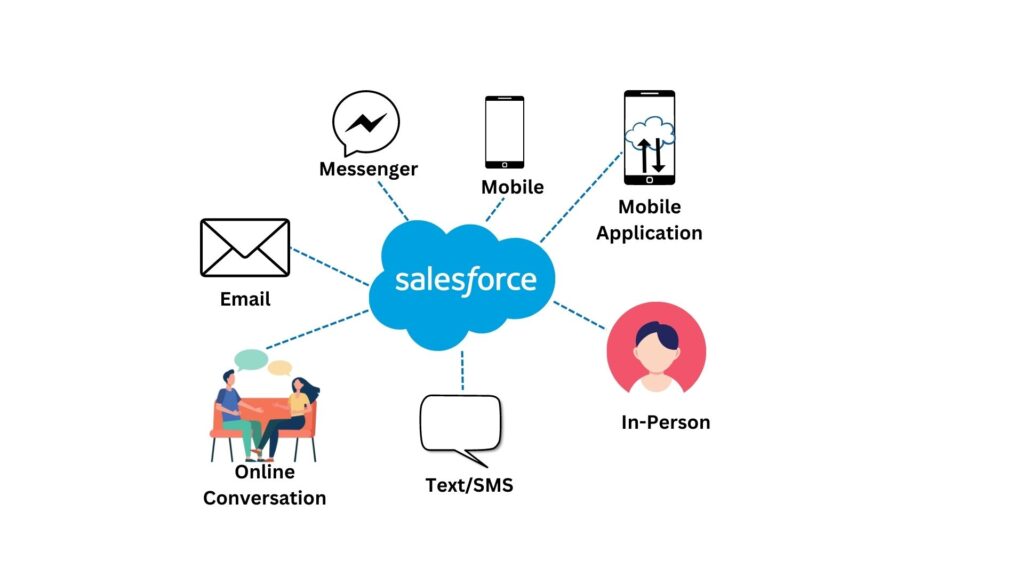Omni-Channel is a Customer Service and Console-based Salesforce functionality that aids in the automated routing of various work items (such as leads and cases) to agents. Based on the agent’s capacity, priority, skill set, and other factors, Omni- Channel automatically sends all the work items to the agents. In this case, the configuration takes care of everything, and no specific work is necessary. Agents can now help clients more effectively, which improves operational effectiveness.
Customer experience has established itself as a critical distinction in almost every business globally for keeping consumers and fostering loyalty. According to research, 73% of consumers use several channels to shop, underscoring the need to offer a consistent customer experience across all your channels.
Using Salesforce omni-channel routing, you can be sure that every time and via every channel, your customers will relate to the best customer support representative.
Why does Salesforce value Omni-Channel?
Customer support representatives usually have little choice but to choose cases from a list view, which opens the door to poorly allocated resources and erroneous job assignments.
Instead, companies may use the Salesforce Omni-Channel configuration to allocate cases to customer service agents in a way that successfully balances resource deployment. Additionally, predefined dashboards and data allow management to keep an eye on agent effectiveness.
The Three C’s
- Complete
- Consistent
- Connected
These are Salesforce’s way of thinking about omni-channel. Omni-Channel maintains work connected and unified for your agents to handle while assisting you in offering clients a thorough and full experience regardless of the channel. It also guarantees that consumers have a consistent experience.
Pillars of Customer Service
The Four Pillars of Customer Service, a framework utilized by Internet Creations, a Salesforce AppExchange, and Consulting Partner, are also covered by Omni-Channel.
- Response time
- Use of resources
- Feedback
- Personalization
These are the Four Pillars of Customer Service. These pillars are addressed by Omni-Channel because agents have a single spot to concentrate their work, and routing allocates the appropriate task to the appropriate agent to give your clients timely assistance and a personalized customer experience.
Key Channels to build an Omni-Channel Experience

Sending a fresh or reduced offer to your customers via email may kick off your omni-channel customer journey. Verify the click-to-open rate (CTOR), which is the proportion of email subscribers who clicked the email’s offer compared to the number of those who merely opened it.
Ensure that your website has an online chat feature that visitors may use to communicate virtually or phone you once they have clicked on your email offer.
Make sure your offer is compelling enough to get visitors to fill out the form and provide you with further information if it directs them to a landing page that is gated. Your sales staff will need this information to follow up with fresh leads.
Omni-Channel Routing and Presence
- Intelligent route work
- Boost your productivity
- Utilize operational insights
Intelligent Route Work
Route cases, leads, or other tasks automatically to the best employee who is on hand. Service Cloud administrators may now set up job distribution based on staff availability, skill sets, and capabilities to handle incoming work.
Employees may instantly update their status, ensuring that urgent work is always given the highest priority.
Boost your Productivity
Omni-Channel Presence and Routing intelligently direct work based on the business priorities rather than dispatching work or having agents choose work at random from queues.
Work is screen-popped into the service console and distributed to workers in real-time, giving them an in-context picture of the customer across all channels. With the option to specify the relative priority and scope of the activity, you can further guarantee that employees set priorities accurately.
Utilize operational insights
Learn more about the frequency with which your employees handle work, the length of time they have been in various statuses, and any patterns in the frequency with which they accept or reject work.
Additionally, you may report on service level agreement adherence, average wait times, and handling times. Utilize these insights to identify issues earlier, respond to, and resolve them.
Benefits of Omni-Channel
- Decreased mean response time
To improve customer service, queries are only given to customer care representatives who are technically capable of handling the task at hand.
The average handling time and desertion rates are both decreased when inquiries are sent to the appropriate agents.
- Increased efficiency of agents
Your customer care representatives may interact with consumers through any channel and easily transition between channels thanks to Salesforce Omni-Channel Routing, significantly increasing overall productivity.
- Prioritization of tasks
Omni-Channel Routing gives inquiries a priority based on their significance, allowing urgent work items to be sent directly to agents in that queue.



